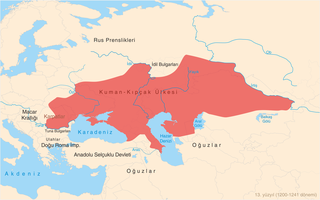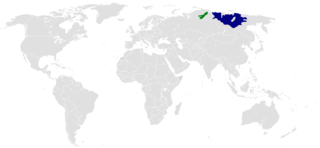Related Research Articles

The Turkic languages are a language family of more than 35 documented languages, spoken by the Turkic peoples of Eurasia from Eastern Europe and Southern Europe to Central Asia, East Asia, North Asia (Siberia), and West Asia. The Turkic languages originated in a region of East Asia spanning from Mongolia to Northwest China, where Proto-Turkic is thought to have been spoken, from where they expanded to Central Asia and farther west during the first millennium. They are characterized as a dialect continuum.

Kazakh or Qazaq is a Turkic language of the Kipchak branch spoken in Central Asia by Kazakhs. It is closely related to Nogai, Kyrgyz and Karakalpak. It is the official language of Kazakhstan and a significant minority language in the Ili Kazakh Autonomous Prefecture in Xinjiang, north-western China, and in the Bayan-Ölgii Province of western Mongolia. The language is also spoken by many ethnic Kazakhs throughout the former Soviet Union, Germany, and Turkey.

Tatar is a Turkic language spoken by the Volga Tatars mainly located in modern Tatarstan, as well as Siberia and Crimea.

Uyghur or Uighur is a Turkic language written in a Uyghur Perso-Arabic script with 8–13 million speakers, spoken primarily by the Uyghur people in the Xinjiang Uyghur Autonomous Region of Western China. Apart from Xinjiang, significant communities of Uyghur speakers are also located in Kazakhstan, Pakistan, Kyrgyzstan, and Uzbekistan, and various other countries have Uyghur-speaking expatriate communities. Uyghur is an official language of the Xinjiang Uyghur Autonomous Region; it is widely used in both social and official spheres, as well as in print, television, and radio. Other ethnic minorities in Xinjiang also use Uyghur as a common language.

Bashkir or Bashkort is a Turkic language belonging to the Kipchak branch. It is co-official with Russian in Bashkortostan. It is spoken by 1.09 million native speakers in Russia, as well as in Ukraine, Belarus, Kazakhstan, Uzbekistan, Estonia and other neighboring post-Soviet states, and among the Bashkir diaspora. It has three dialect groups: Southern, Eastern and Northwestern.

The Kipchaks or Qipchaks, also known as Kipchak Turks or Polovtsians, were Turkic nomads and then a confederation that existed in the Middle Ages inhabiting parts of the Eurasian Steppe.

The Karaim language, also known by its Hebrew name Lashon Kedar is a Turkic language belonging to the Kipchak group, with Hebrew influences, similarly to Yiddish or Judaeo-Spanish. It is spoken by only a few dozen Crimean Karaites in Lithuania, Poland, Crimea, and Galicia in Ukraine. The three main dialects are those of Crimea, Trakai-Vilnius and Lutsk-Halych, all of which are critically endangered. The Lithuanian dialect of Karaim is spoken mainly in the town of Trakai by a small community living there since the 14th century.
Chuvash is a Turkic language spoken in European Russia, primarily in the Chuvash Republic and adjacent areas. It is the only surviving member of the Oghur branch of Turkic languages, one of the two principal branches of the Turkic family.

Crimean Tatar, also called Crimean, is a moribund Kipchak Turkic language spoken in Crimea and the Crimean Tatar diasporas of Uzbekistan, Turkey, Romania, and Bulgaria, as well as small communities in the United States and Canada. It should not be confused with Tatar, spoken in Tatarstan and adjacent regions in Russia; the two languages are related, but belong to different subgroups of the Kipchak languages, while maintaining a significant degree of mutual intelligibility. Crimean Tatar has been extensively influenced by nearby Oghuz dialects and is also mutually intelligible with them to varying degrees.
Cuman or Kuman was a West Kipchak Turkic language spoken by the Cumans and Kipchaks; the language was similar to today's various languages of the West Kipchak branch. Cuman is documented in medieval works, including the Codex Cumanicus, and in early modern manuscripts, like the notebook of Benedictine monk Johannes ex Grafing. It was a literary language in Central and Eastern Europe that left a rich literary inheritance. The language became the main language of the Golden Horde.
The Volga Turki language was a literary language used by some ethnic groups of the Volga-Ural region from the Middle Ages until the 19th century.

Khalaj is a Turkic language spoken in Iran. Although it contains many old Turkic elements, it has become widely Persianized. Khalaj has about 150 words of uncertain origin.
The Urums are several groups of Turkic-speaking Greek Orthodox people native to Crimea. The emergence and development of the Urum identity took place from 13th to the 17th centuries. Bringing together the Crimean Greeks along with Greek-speaking Crimean Goths, with other indigenous groups that had long inhabited the region, resulting in a gradual transformation of their collective identity.

The Siberian Turkic or Northeastern Common Turkic languages, are a sub-branch of the Turkic language family. The following table is based upon the classification scheme presented by Lars Johanson (1998). All languages of the branch combined have approximately 750,000–1 million native and second language speakers, with most widely spoken members being Yakut, Tuvan and Northern Altai. Despite their usual English name, two major Turkic languages spoken in Siberia, Siberian Tatar and Southern Altai, are not classified as Siberian Turkic, but are rather part of the Kipchak subgroup.

Yakutyə-KOOT, also known as Yakutian, Sakha, Saqa or Saxa, is a Turkic language belonging to Siberian Turkic branch and spoken by around 450,000 native speakers, primarily the ethnic Yakuts and one of the official languages of Sakha (Yakutia), a federal republic in the Russian Federation.
This article covers the phonology of the Uyghur language. Uyghur, a Turkic language spoken primarily in the Xinjiang Uyghur Autonomous Region features both vowel harmony and vowel reduction.
Siberian Tatar (Сыбырца) is a Turkic language spoken in Western Siberia, Russia, primarily in the oblasts of Tyumen, Novosibirsk, Omsk but also in Tomsk and Kemerovo. According to Marcel Erdal, due to its particular characteristics, Siberian Tatar can be considered as a bridge to Siberian Turkic languages.

The Oghuz languages are a sub-branch of the Turkic language family, spoken by approximately 108 million people. The three languages with the largest number of speakers are Turkish, Azerbaijani and Turkmen, which, combined, account for more than 95% of speakers of this sub-branch.
The Crimean Tatar language consists of three dialects. The standard language is written in the middle dialect, which is part of the Kipchak-Cuman branch. There is also the southern dialect, also known as the coastal dialect, which is in the Oghuz branch, and the northern dialect, also known as nogai dialect, which is in the Kipchak-Nogai branch.
References
- ↑ Encyclopedia of Bashkortostan.
- ↑ Yazyki miraЯзыки мира[Languages of the World]. Vol. 2. Indirk: Институт языкознания (Российская академия наук). 1997. pp. 19–20.
- ↑ Махмутова Л. Т. Опыт исследования тюркских диалектов: мишарский диалект татарского языка. — М.: Наука, 1978
- ↑ Some dialects are close to Kirghiz (Johanson 1998)
- ↑ Nevskaya, I.A. "The Teleut Language". Endangered Languages of Indigenous Peoples of Siberia. UNESCO . Retrieved 2021-07-16.